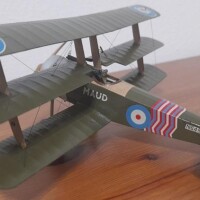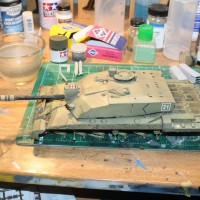Sopwith Triplane 1-48, Eduard, Flt Charles Dawson Booker, 8 Sqn. RNAS, 29 victories
This is my last rebuild from an old wreck by Eduardo. Next time I will only devote it to the new beautiful kits that I have in my stash. As usual, the wreck was taken apart, cleaned and reassembled with lots of missing details added. Motor assembled new, from my collection of spare parts. Also all struts and machine gun added new. It's not top, but I think I managed to save the model, it's hard to find a kit today.
The triplane was developed by the company's experimental department as a private enterprise, the project was led by designer Herbert Smith. Apart from the obvious difference in wing configuration, the aircraft shared many similarities with the company's successful biplane fighter, the Sopwith Pup.
The triplane quickly proved capable of extraordinary maneuverability and was therefore quickly considered a success among those squadrons that flew it. Type praise extended to enemy pilots; Imperial Germany Triplane studied extensively on captured examples and produced numerous triplanes shortly afterwards. Still, the Triplane was produced in relatively small numbers compared to the more conventional Sopwith Pup. The decision was made to withdraw the Triplane from active service as increasing numbers of Sopwith Camels arrived in the second half of 1917. The surviving Triplanes continued to serve as operational training and experimental aircraft until the months following the end of the conflict. The Triplane was originally powered by a 110 hp Clerget 9Z nine-cylinder rotary engine and>[13] rotary engine, but this did not provide a significant improvement in performance, the only apparent benefit being a slight increase in rate of climb.110 hp Le Rhône. However, most production examples were instead fitted with the more powerful 130hp Clerget 9B rotary. The Triplane's combat debut was very successful. The exceptional rate of climb and high service ceiling gave the new fighter a considerable advantage over the Albatros D.III, even though the Triplane was slower. in a dive. During April 1917, Manfred von Richthofen, better known as the Red Baron, remarked that the Triplane was the best Allied fighter at the time, a sentiment echoed by other senior German officers such as Ernst von Hoeppner. More triplanes were captured and the subject of considerable evaluation and study. The aircraft's performance so impressed the German that it sparked a brief triplane craze among German aircraft manufacturers. Their efforts resulted in no fewer than 34 different prototypes, including the Fokker V.4, the prototype of the successful Fokker Dr.I. The pilots nicknamed the plane Trihound or simply Tripe. The triplane was brilliantly piloted by "B"; Flight 10 Naval Squadron, better known as "Black Flight". This all-Canadian flight was commanded by ace Raymond Collishaw. Their aircraft named Black Maria, Black Prince, Black George, Black Death and Black Sheep. Black Flight claimed 87 German aircraft in three months in Triplane equipment. Collishaw scored 34 of his eventual 60 victories in the aircraft, making him the top three-plane ace. They were recognizable by their black painted fins and fairings.
The Triplane's combat career was relatively short, in part because it proved difficult to repair. The fuel and oil tanks were inaccessible without removing the wings and fuselage; even relatively minor repairs had to be done in the rear repair depots. During the summer of 1917, spare parts became difficult to obtain, leading to the reduction of 1st Naval Squadron from 18 to 15.
Major Charles Dawson Booker DSC (21 April 1897 – 13 August 1918) was an English World War I fighter ace who claimed 29 victories. He was raised to high rank when relatively young as a result of his gallantry and unwavering devotion to his country.
He served on the Belgian coast, first with 5 Naval Wing, then with 8 Naval Squadron from May to October 1916 and further inland for another year, to November 1917. He did not open his victory certificate until 23 January 1917, after his transfer. to 8 Naval when he crashed an Albatros D.III out of control while piloting a Sopwith Pup.
After a few months he used the Sopwith Triplane to score four times in April, becoming Ace 30. Even at this early stage, despite his youth, he was flight commander of C Flight. One of his wingmen described him as "...a little fellow, usually very quiet, who is not afraid of anything, but will run a mile from any girl...he hopes the war will go on forever because he loves the air." fighting, and if the war were to end, he fears he might not find a suitable job."
May was a particularly notable month for Booker with nine victories, including a triple on the 24th. On 22 June, after his 17th victory, he was awarded the Distinguished Service Cross; the citation noted his three wins totaled on May 24.
After three victories in July, he shot down and severely wounded German ace Hauptmann Adolf Ritter von Tutschek, commander of Jasta 12, on 11 August 1917; Tutschek would recover half a year. In the same fight, Booker was so badly shot that German ace Viktor Schobinger called Booker the winner. Booker actually managed to force his destroyed 'Trihound' to crash land in friendly territory. He used Sopwith Triplanes (his usual aircraft was serial number N5482, which he jokingly called 'Maude') to stretch his string of triumphs to 23 by this time. A crash landing on the 11th was the end of 'Maude'. It was his horse for at least 14 triumphs.
On 27 September he scored his first victory flying a Sopwith Camel; shot down German ace Oberleutnant Hans Waldhausen of Jasta 37, who became a prisoner. However, Naval 8, and Booker, were withdrawn from action in November and returned to England. Booker was ranked fourth out of 25 aces in this prestigious squadron.
After a few months back in England, he returned to France as a major commanding the 201st Squadron of the newly formed Royal Air Force. He was given command in March, just before his 21st birthday. He will be flying the Camel again.
He led 201 examples, recording two victories in May and one in July. In May, on 27 May, he identified the body of his friend, Australian ace Robert Little, who had been shot down nearby.
On August 13, 1918, he led a novice pilot on an orientation tour of their aerial battlefield. Two Camel pilots encountered a formation of at least six experienced pilots from Jagdgeschwader 2. Booker tackled them alone to cover the retreat of the green pilot. It was the rookie who verified Booker's last three wins. However, Jasta 12 ace Leutnant Ulrich Neckel eventually shot Booker down.
Booker was buried at Vignacourt British Cemetery, Somme, France.












A well-modelled piece of interesting aviation history, Milan.
Thank you George.
Very nice save, Milan and as George said, quite interesting history as well @milantesar! 👍
Thank you Gary.
Very nice refurb on the Sopwith Triplane. A few years back, I visited a small aviation museum, located in Calgary Alberta Canada, that had a Triplane replica. It was reported to me by museum staff that their replica was made from plans drawn-up from Sopwith plans, and that the aircraft was exact in every detail. I viewed that airframe while it was still uncovered, so all of the internal structure and details could be seen; it all looked very correct. The reason given for the uncovered airframe was that the museum was still trying to decide whether to use period-correct doped linen (flamable) or a less-flamable modern covering. other than the cevering, the Sopwith Triplane was finished. This was in the early 2000's and I have not followed-up to see if they ever finished the Triplane. In fact, I do not know if this little museum still exists or not. It would be a shame if it closed because thay had some very neat exhibits (including a complete Lancaster sitting out front).
Thanks Marvin, very interesting information.
Another outstanding save from the shelf of doom! Great job Milan! This is the exact reason I save all my unused bits and pieces.
That's right, it's good to have parts on hand that can be used to make a lot of things.
Nice ave on this. Milan. the Triplane kit was Eduard's first "modern" kit - i.e., not a limited-run kit. You have a beautiful result here.
The Tripe gets everything right, where the Dr.I mostly got everything wrong. The most important was having ailerons on all three wings, so the whole flight structure was contributing to whatever maneuver. The Dr.I, which only had ailerons on the upper wing, was essentially dragging the rest of the airframe through a maneuver. This is why the triplane could easily outmaneuver a Dr.I.
Thanks Tom, yes I agree with your conclusions.
Very nice Tripe build.
Thank you Dan.
🙂 ... Greetings ... 🙂 :
As can be seen, the save and dedication paid off.
Beautiful piece of aviation history reflected on a model, nice work Milan.
I'm glad you like it, thank you.
Excellent save, Milan @milantesar
Very interesting historical information as well.
I'm glad you like it, thank you.
Very nice build. @milantesar
Thank you John.
Great save and rebuild Milan, the history narrative was very informative. The tripe was an interesting concept that just didn't quite make it, imagine what it could have been with more H.P.
Thanks Ian, yes that would be interesting.
Good work on that rebuild. The Sopwith Tripe is my favorite WWI aircraft.
Thanks Chas, glad you like it. All the positive comments are an inspiration for me to continue with the constructions.
Lovely Tripehound!
Great build!